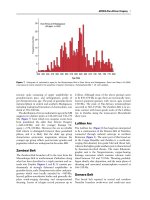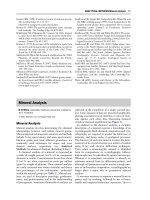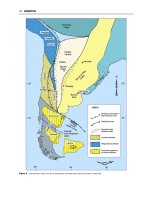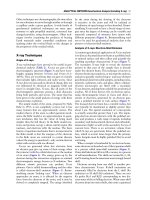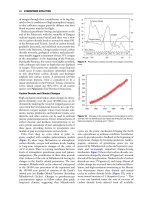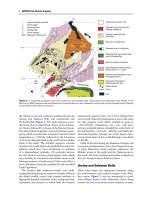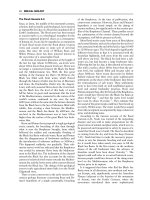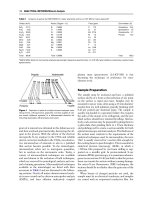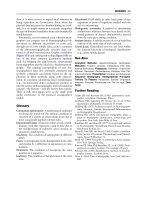Encyclopedia of geology, five volume set, volume 1 5 (encyclopedia of geology series) ( PDFDrive ) 2033
Bạn đang xem bản rút gọn của tài liệu. Xem và tải ngay bản đầy đủ của tài liệu tại đây (109.08 KB, 1 trang )
190 PALAEOZOIC/Silurian
long, with a relatively flat-lying Late Ordovician
and Early Silurian succession. The Silurian follows
the latest Ordovician with only a minor break within
the Ellis Bay Formation, which is followed by the
Becscie, Gun River, Jupiter, and Chicotte formations,
all of which are of Llandovery age. These rocks consist of alternating limestones and shales, all deposited
on a shallow-marine continental shelf and yielding
excellently preserved macrofossils (particularly brachiopods, corals, and bryozoans) and microfossils
(particularly condonts, ostracods, acritarchs, and
chitinozoans). Since graptolites are poorly represented, the principal correlations have been achieved
by using conodont biozones.
Podolia
Figure 4 Section through most of the Silurian in southern On
tario, Canada, near Niagara Falls. The lower limestones are Late
Llandovery and Early Wenlock; they are overlain by the Late
Wenlock Rochester Shale Formation, which is in turn overlain
by Ludlow, Pridoli and earliest Devonian limestones.
to the Steinsfjorden formations were all deposited in
shallow-marine environments on the continental
shelf and include abundant brachiopods and other
macrofossils and microfossils. Above these, the Late
Wenlock and Ludlow Sundvollen and Stubdal formations were deposited under freshwater or continental
non-marine conditions. The Pridoli is not known in
this region. On the Baltic island of Gotland, Sweden,
there are flat-lying outcrops of Late Llandovery to
Ludlow rocks, in many cases forming imposing sea
cliffs and containing notable bioherms. The visible
sequence starts with the Visby Marl, which spans the
Llandovery–Wenlock boundary, and this is succeeded
by the bioherms of the Hoă gklint Formation. Ten further Wenlock and Ludlow formations follow, including the Klinteberg Formation, which spans the
Wenlock–Ludlow boundary and is famous for its
reefs of the pentameride brachiopod Conchidium, originally described by Linnaeus in the early eighteenth
century.
Anticosti
Anticosti Island lies near the mouth of the
St Lawrence River, Canada, and is nearly 100 km
The area bordering the Dnestr River has been part of
both Poland and the USSR in the past and is now in
the west of Ukraine. A very thin band of Middle
Llandovery rocks lies unconformably on Middle Ordovician rocks and is followed paraconformably by
the Wenlock Kitaigorod Formation, the Bagovitsa
Formation, which spans the Wenlock–Ludlow
boundary, the Ludlow Malmovtsy Formation, and
the Pridoli Rashkov and Dzwinogorod formations,
which are themselves followed conformably by earliest Devonian strata. All are marine, with many limestones but much clastic fine-grained input, and have
yielded very abundant macrofossils and microfossils.
The latest Silurian rocks, locally termed the Skala
Stage, were a strong candidate for the stratotype of
the latest formal series of the Silurian, but the vote
went to the Pridoli area of the Czech Republic.
Methods of Dating and Correlation
The system is well-constrained by radioisotopic ages
down to the level of the series (see above for the dates
in Ma), but within the series the dating and correlation are achieved by using quickly evolving fossils.
The best of these are the graptolites, upon which
more than 30 biozones have been based, covering
the entire Silurian. Because of their planktonic mode
of life, these quickly evolving lineages dispersed very
rapidly, enabling correlation across all continents and
terranes. However, graptolites are often uncommon
or even absent in rocks deposited under very shallowwater conditions, and, in these rocks, microfossils,
particularly conodonts, are used. However, there are
often four or five successive graptolite biozones
during the period of a single Silurian conodont biozone. Conodonts, acritarchs, chitinozoans, and spores can often be recovered from small samples, for
example the rock chips produced through boring by
